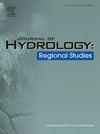How have the drawdown zones of large reservoirs changed over the past two decades in China?
IF 4.7
2区 地球科学
Q1 WATER RESOURCES
引用次数: 0
Abstract
Study region
This study focuses on the Reservoir Drawdown Zones (RDZs) of 727 large reservoirs in China.
Study focus
The research investigates the spatiotemporal dynamics of RDZs from 2000 to 2021, utilizing remote sensing data from the Global Surface Water Dataset (GSWD). It examines trends in RDZ area changes, their spatial distribution across major river basins, and the key drivers, including reservoir operations, climate variability, and human activity.
New hydrological insights for the region
According to the findings, RDZ zones constitute around 35 % of a major reservoir's maximum water surface area. Although there are significant fluctuations over time, the total area of RDZs shows an increasing trend on a temporal scale. Prior to 2015, there were some variations in the growth of RDZ areas, which were likely caused by external factors such as operating plans, early reservoir commissioning, and climate change. The capacity of reservoir operations to adjust to climate change was enhanced after 2015 due to the construction and operation of additional large reservoirs, as well as improvements in scheduling and management. As a result, RDZ regions continued to expand at a rate significantly faster than before 2015. Geographically, RDZs are primarily distributed in eastern, central, and southern China, particularly in the Songhua and Liaohe River Basins, the Yangtze River Basin, and the Pearl River Basin. From a spatial perspective, local population density, economic growth, and water resource management techniques, in addition to geographic and climatic factors, may influence the distribution patterns of RDZs across reservoirs of varying sizes. In RDZ regions, more than one-fourth of the reservoirs exhibit notable interannual changes, where climate or human activity may be the primary driving factor. This challenges the conventional wisdom that RDZ regions typically exhibit consistent interannual patterns.
求助全文
约1分钟内获得全文
求助全文
来源期刊

Journal of Hydrology-Regional Studies
Earth and Planetary Sciences-Earth and Planetary Sciences (miscellaneous)
CiteScore
6.70
自引率
8.50%
发文量
284
审稿时长
60 days
期刊介绍:
Journal of Hydrology: Regional Studies publishes original research papers enhancing the science of hydrology and aiming at region-specific problems, past and future conditions, analysis, review and solutions. The journal particularly welcomes research papers that deliver new insights into region-specific hydrological processes and responses to changing conditions, as well as contributions that incorporate interdisciplinarity and translational science.
 求助内容:
求助内容: 应助结果提醒方式:
应助结果提醒方式:


